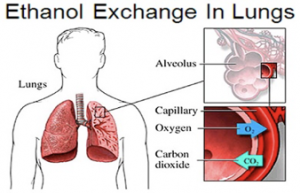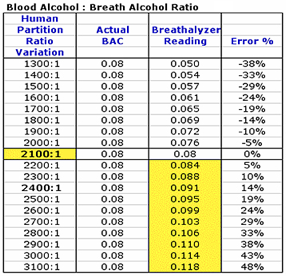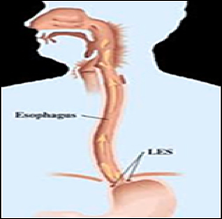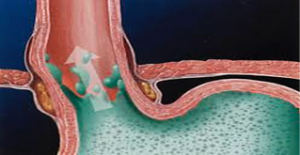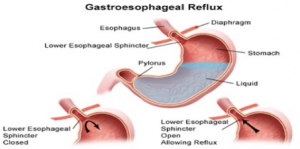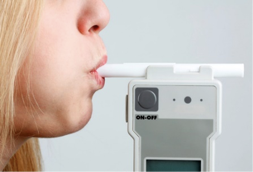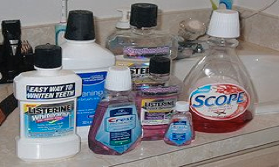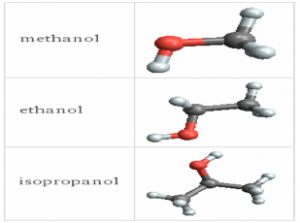Was Your Breath Test ACCURATE
You can’t trust the government’s scientific evidence. In many cases the amount of alcohol you consumed would not generate a BAC as high as the government claims. For instance, if you drank three-4 oz. glasses of wine, or three-12 oz. beers, or three-1 oz. shots over 2 hours, and the officer tells you that your BAC is 0.14%, that is scientifically impossible and you are being wrongfully accused. Locate your body weight and the number of drinks you drank total. This is your total BAC if you drank those drinks in 1 hour. Subtract 0.015% for every hour it took to consume your number of drinks.
For example:
150 lb person drinks 3 beers in 1 hour = 0.08% BAC
150 lb person drinks 3 beers in 2 hour = 0.065% BAC (0.08% – 0.015% for 2nd hour)
150 lb person drinks 3 beers in 3 hour = 0.050% BAC (0.065% – 0.015% for 3rd hour)
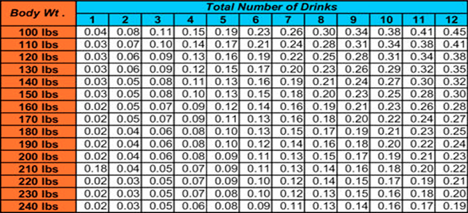
These are rough estimates with many factors that influence the results. But if your estimated BAC is lower than the government’s breath test result, there is a problem with the government’s case.
Blood-Breath Partition Ratio Is Inaccurate Based on Individual Differences
The biggest problem with breath testing, which leads to the most wrongful convictions, is the partition ratio error associated with breath testing. DUI breath testing devices are calibrated to assume that that the “breath alcohol” measured by the breath device accurately reflects the amount of alcohol in the blood based on a 2100-to-1 blood to breath ratio. The Blood Breath Partition Ratio assumes that 2100mL of breath contains the same amount of alcohol as 1 mL of blood. Many studies over the years have found a range of partition ratios in the population from about 900 to 3400. The partition ratio is constantly changing during the course of drinking and varies up to 10% within the same person. And there’s no way to determine what a given person’s ratio was at the time of the DUI breath test. For every 200 points lower your partition ratio is below 2100 the breath test will read falsely high by about 0.01%. Say you blow and the breath machine reads 0.08%. If your partition ratio was 1300 (not 2100 like the machine assumes) at the time you gave the breath test your true blood alcohol concentration would be 0.05% which is under the legal limit. Most people assume that if you blow over the legal limit your guilty, but as you can see that is not always true.
Breath Machines Don’t Measure Blood Alcohol Concentration
The problem with breath testing is that in most cases it is not very accurate and can result in an innocent person being wrongfully convicted. For instance, a person with a true blood alcohol level of 0.05%, which is under the legal limit and is at the level where there is no impairment, could blow into a breath machine and blow a 0.10% reading. This falsely high reading occurs because the breath machine measures alcohol from your breath and not your blood. The government uses this breath alcohol reading (BrAC) to prove your blood alcohol concentration (BAC). The problem is that scientifically, breath alcohol concentration (BrAC) and blood alcohol concentration (BAC) are not the same thing. The breath machine measures breath alcohol concentration, which is the concentration of alcohol contained in the breath not the alcohol concentration in the blood. The only way to determine the blood alcohol concentration in the blood is to draw blood and measure the alcohol. Only blood alcohol causes impairment, not breath alcohol. Breath alcohol doesn’t do anything to you. The government uses breath testing as an indirect method for testing a person’s blood alcohol concentration. Breath testing is fast, cheap, and easier than blood testing that is why the government likes it; however, it isn’t accurate.
Absorption Can Cause False High Results
Breath alcohol testing while alcohol is still absorbing into your bloodstream results in falsely high BAC readings. During the absorption stage, which can last three hours or more after you finish drinking, the BAC in arterial blood is as much as 60% higher than the BAC in venous blood. Because the alveolar deep-lung air blown into the breath machine is bathed in arterial blood, not venous blood, a falsely high BAC is generated. Most credible scientists agree that a breath test should not be given while a person is still absorbing alcohol.
Inherent Error Rate In Breath Alcohol Testing
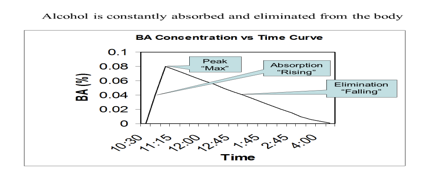
Even if the you assume that maintenance and calibration of the breath machine is perfect, the breath test is administered exactly according to procedure, and no background or physiological factors exist that would produce false results, most experts agree the inherent error rate is about +/- .02% for DUI breath testing. For example, a breath test should read 0.08% +/- 0.02%. this means you can be as high as a 0.10% or as low as 0.06%. Scientifically, that’s as good as the government’s breath testing results get and that is why many innocent people plead guilty to DUI because they are unaware of these problems with the government’s tests.
Rising Blood Alcohol Level
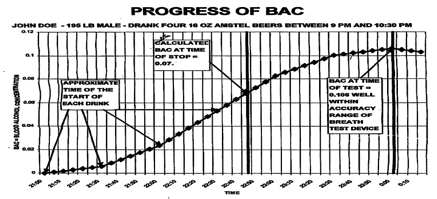
To be guilty of DUI you have to have a blood alcohol concentration over 0.08% at the time of driving. If your blood alcohol concentration is rising when you are given the chemical test, you may have been under the legal limit at the time of driving. For example, you could blow a 0.11% at the police station but be 0.07% BAC when you got pulled over. Why? Because your blood alcohol level can increase by 0.02% or more an hour, if 2 hours pass from the time you are stopped till the time you are given a chemical test you could easily rise from 0.07% to 0.11%. Alcohol takes as long as three hours or more to fully absorb into your bloodstream and create your peak blood alcohol level. This is critical if the DUI traffic stop occurred relatively soon after you finished drinking. You can see that even if your BAC was above .08% when the breath test occurred at the police station, it may well have been below .08% when you were driving. It’s only the blood alcohol level while driving that counts for DUI purposes.
Heartburn Can Cause Falsely High Breath Test Readings
Suffering from Gastroesophageal Reflux Disease (GERD), acid reflux or heartburn can “fool” the DUI breath machines, causing an erroneously high reading. GERD causes alcohol vapors which are located in the stomach to travel back up through the esophagus, throat and mouth. When this happens, the person blows this “mouth alcohol” into the breath machine. The machine then provides a dramatically higher reading than the person’s true BAC. A person with a true BAC of .05% can blow into a breath machine and obtain a reading of 0.20% or higher. Consequently, the person is arrested and charged with a crime when they could in fact be innocent.
Low-Carb Diets Can Cause Falsely High Breath Test Readings
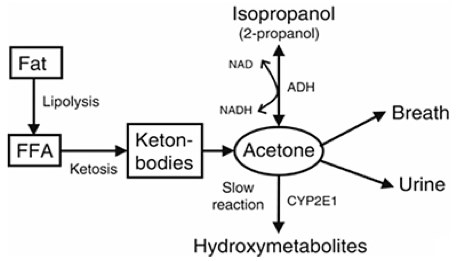
During metabolism, a person’s body on a high protein low carbohydrate diet produces compounds called ketones. If a person consumes carbohydrates, as in drinking alcohol, when these ketones are present the body will produce isopropyl alcohol. Since ethanol and isopropyl alcohol are not distinguished by most breath testing machines it can result into a falsely high-test result.
Diabetes or Hypoglycemia Can Cause Falsely High Breath Test Readings

If you are hypoglycemic, borderline diabetic or if you have diabetes, then the consumption of alcohol, even in small amounts, will cause your body to convert elevated levels of acetone into isopropyl alcohol. Since ethanol and isopropyl alcohol are not distinguished by most breath testing machines it can result in a falsely high-test result.
Abnormal Hematocrit Can Cause Falsely High Breath Test Readings
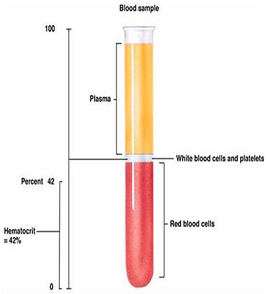
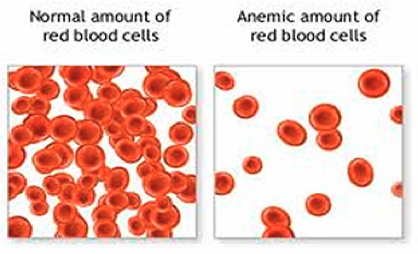
The hematocrit represents the fraction of whole blood composed of red cells and is correlated with the aqueous content of blood. The higher the hematocrit, the lower the concentration of water in blood. The average hematocrit for normal, healthy males is 47%, with a range of 40-54%; for females the average is 42% and the range is 36-47%. Since ethanol dissolves almost entirely in the aqueous component of blood, two individuals with identical actual BAC’s but with different hematocrits would be expected to produce different Breathalyzer results. The person with the higher hematocrit, and therefore lower blood-water content, would necessarily be characterized by a higher concentration of ethanol in the aqueous component of his/her blood and consequently, by a higher Breathalyzer reading. Given that the breath machine is calibrated at a hematocrit count of 45% studies have shown that the normal variation in hematocrit can produce errors in breath test results in the 10-14% range. Therefore, a person with a 0.07% BAC will register 0.08% on the breath machine.
Mouth Alcohol Can Produce Falsely High Results
Ideally, DUI breath testing devices detect alveolar air of the deep lungs, which is loosely correlated with blood alcohol level. But the breath testing machine can be “tricked” by latent alcohol in the mouth often caused by burping, belching, or the recent use of cough syrup, cold medicine, mouthwash or breath spray. When the breath machine detects mouth alcohol rather than deep lung air, it gives readings greatly higher than the true BAC. This becomes a particular problem for people with dentures, denture adhesives, braces, cavities, food impactions, orthodontic work or who have food particles trapped between their teeth. Food particles act like a sponge and trap the alcohol in the mouth. Don’t forget the breath machine measures molecules of alcohol so it doesn’t take much mouth alcohol contamination to produce a falsely high breath test result.
Fail to Observe 15-Minute Observation Period Prior to The Breath Test
California law requires police to watch a DUI suspect continuously for at least 15 minutes prior to administering the breath alcohol test. During that time the officer must make sure that the person does not consume anything, burp, belch, hiccup or regurgitate. Any of these may cause alcohol to travel from the stomach to the mouth. Blowing this “mouth alcohol” into the breath machine triggers a falsely high BAC reading. Officers usually don’t follow this required observation procedure because they are doing their paperwork, writing reports, setting up the machine and conversing with their partners. Failure to follow state law casts doubt on the validity of the test result because of the possible contamination of the breath sample.
Breathing Patterns Can Produce Falsely High Results
Remember the harder you blow the higher you go. That is why police tell you to keep blowing because they know it will result in the highest possible result even if is not the most accurate result. A breath sample longer than 10 seconds can generate a significantly higher BAC reading because the machinery is calibrated to test a 10 second sample. If a person holds his or her breath for a short period of time before blowing into the breath device can increase the alcohol content in exhaled air by up to 15%. Additionally, a person who breaths shallow or holds her breath may blow residual mouth alcohol, again producing a higher reading than her true BAC.
Breath Temperature Can Produce Falsely High Results
Breath temperature is critically important in obtaining and accurate breath test result. Most of the machines used in El Dorado county don’t have a way of measuring breath temperature so they arbitrarily calibrate the machines to read everyone’s breath temperature as 34°C. The first problem is that the average breath temperature for humans is not 34°C but 35.7°C and varies as much as ± 1°C amongst different individuals. In addition, every person has a normal diurnal (daily) variation of 1°C. Females also have a temperature variation of about 1°C with their menstrual cycle. These temperature variations are normal. In addition, there are factors that can elevate body temperature above the normal range including the flu or physical or emotional trauma. So right off the bat the breath machine reading is about 10% higher than it should be. An elevation in body temperature of 1°C (1.8°F) results in a 7% higher value in the result. Therefore, a person with a body temperature of 100.6°F and with an actual blood alcohol of 0.07% will register a value of 0.08% by the breath test. As can be seen from this hypothetical example, a small difference in body temperature can make the difference of guilt or innocence of drunk driving in defendants with a BAC close to the legal limit.
Breath Testing Machines Mistake Other Chemicals for Alcohol
DUI Breath alcohol testing machines mistakenly detect non-alcohol compounds for alcohol. Among the compounds most commonly mistaken for alcohol are methanol, isopropanol, ethylene, toluene, nitrous oxide, diethyl ether, acetonitrile and isopropanol. The presence of any of these compounds in the DUI suspect’s lung tissue will likely cause a false, or falsely high, blood alcohol reading. People frequently ingest these compounds at work or in other environments where the chemicals are present.
Expired Simulator Solution Can Produce False Results

The breath test machine uses an external source of alcohol vapor as a way of verifying that the machine is working properly. If this solution is either mixed incorrectly or is out of date, the BAC reading is not reliable and subject to suppression.
RFI Interference
DUI breath tests use electromagnetic or electrochemical methods to analyze breath samples for alcohol. The problem is that breath machines can “pick up” radio frequencies sent out by other devices which can interfere with the accuracy of the machine’s BAC readings. Devices that produce radio frequency interference (RFI) include cell phones, radio transmitters, refrigerators, and microwave ovens. These devices are found in an around the areas where breath tests are given to arrestees either in the field or in the police station.
Title 17 Regulations – Breath/Blood Testing Requirements
California Code of Regulations Title 17 sets forth procedures that must be followed by the government when they administer breath tests and when they test breath samples. Since there is a high potential for inaccurate test results when proper procedures are not followed, the government mandates the procedures and protocols for forensic testing of breath samples in California. If the government can’t prove beyond a reasonable doubt that they complied with State law, you can win in court because the forensic evidence is compromised.
Title 17 Regulations – 15 minute Observation period
The law requires that a person given a breath test be placed under continuous observation for at least fifteen minutes prior to collection of the breath sample (CCR Title 17, Sec. 1219.3). The 15-minute observation period is required for 2 reasons to make sure there is no mouth alcohol to contaminate the breath sample and to make sure the person has not ingested alcoholic beverages or other fluids, regurgitated, vomited, eaten, or smoked which could also contaminate the breath sample. In almost all DUI cases, the first breath test given by the side of the road is given before 15 minutes has elapsed making its results suspect. In other cases, people will smoke, have gum, or chew tobacco during the 15-minute observation period. This violates the legal requirements for breath testing and requires a new 15-minute observation to begin upon removal of the foreign substance. The other area where we find error is that many officers do not continuously monitor the person for the 15-minute observation period because they are doing their paperwork or other police work associated with the DUI investigation and arrest. If the government can’t prove beyond a reasonable doubt that they complied with the 15-minute observation period, you may have a winning argument in court because the forensic evidence is compromised.
Title 17 Regulations – Accuracy Checks
On all breath devices used in California there must be periodic accuracy checks. These tests must be conducted every 10 days or 150 tests whichever comes first. In many cases, the accuracy checks are out of compliance which means that any breath result given by that specific breath machine is unreliable. It’s important in every case to obtain the accuracy check logs to determine if the law enforcement agency complied with state law. If the government can’t prove beyond a reasonable doubt that they complied with the required accuracy checks, you can win because the forensic evidence is compromised.
Failure To Comply With California’s Title 17 Regulations
A failure to follow the regulations can result in inaccurate alcohol test results. That is why in a California DUI case if the evidence demonstrates that the person administering the test or agency maintaining the testing device failed to follow Title 17 regulations the jury is given an instruction that states “In evaluating any test results in this case, you may consider whether or not the person administering the test or the agency maintaining the testing device followed the regulations of the California Department of Public Health [Title 17].” The most important sections relevant to DUI testing are as follows:
California Code of Regulation 1215.1
(c) “Breath Alcohol Analysis” means analysis of a sample of a person’s expired breath, using a
breath testing instrument designed for this purpose, in order to determine the concentration of
ethyl alcohol in the person’s blood.
(d) “Concentration” means the weight amount of alcohol contained in a unit volume of liquid or
a unit volume of gas under specified conditions of temperature and pressure; in the case of a
solid tissue specimen, “concentration” means the weight amount of alcohol contained in a unit
weight of specimen.
1219.3. Breath Collection
A breath sample shall be expired breath which is essentially alveolar in composition. The
quantity of the breath sample shall be established by direct volumetric measurement. The breath
sample shall be collected only after the subject has been under continuous observation for at least
fifteen minutes prior to collection of the breath sample, during which time the subject must not
have ingested alcoholic beverages or other fluids, regurgitated, vomited, eaten, or smoked.
1221.4. Standards of Procedure
(a) Procedures for breath alcohol analysis shall meet the following standards:
(1) For each person tested, breath alcohol analysis shall include analysis of 2 separate breath
samples which result in determinations of blood alcohol concentrations which do not differ from
each other by more than 0.02 grams per 100 milliliters.
(2) The accuracy of instruments shall be determined.
(A) Such determination of accuracy shall consist, at a minimum, of periodic analysis of a
reference sample of known alcohol concentration within accuracy and precision limits of plus or
minus 0.01 grams % of the true value; these limits shall be applied to alcohol concentrations
from 0.10 to 0.30 grams %. The reference sample shall be provided by a forensic alcohol
laboratory.
1. Such analysis shall be performed by an operator as defined in Section 1221.4 (a)(5), and the
results shall be used by a forensic alcohol laboratory to determine if the instrument continues to
meet the accuracy set forth in Section 1221.4 (a)(2)(A).
(B) For the purposes of such determinations of accuracy, “periodic” means either a period of
time not exceeding 10 days or following the testing of every 150 subjects, whichever comes
sooner.
(3) Breath alcohol analysis shall be performed only with instruments for which the operators
have received training, such training to include at minimum the following schedule of subjects:
(A) Theory of operation;
(B) Detailed procedure of operation;
(C) Practical experience;
(D) Precautionary checklist;
(E) Written and/or practical examination.

